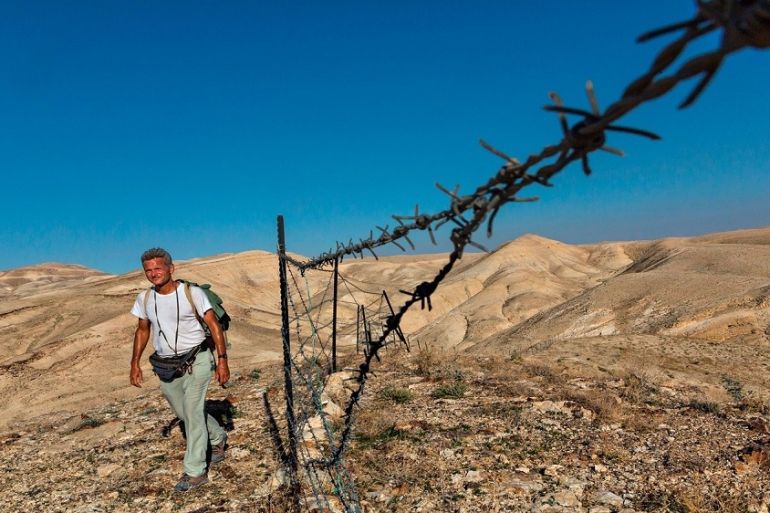Journalist retraces ancient path of human migration
Paul Salopek is covering 21,000 miles on foot on a seven-year journey to retrace an ancient migration path from Africa.

December 18 marks the United Nations’ International Migrants Day, which calls for the protection of migrants’ rights.
Some 244 million people worldwide are migrants – approximately 20 million of whom are refugees. The migrant population is greater than the number of people living in Russia, South Africa and Saudi Arabia.
Keep reading
list of 4 items‘Mama we’re dying’: Only able to hear her kids in Gaza in their final days
Europe pledges to boost aid to Sudan on unwelcome war anniversary
Birth, death, escape: Three women’s struggle through Sudan’s war
Since 2000, the number of migrants has risen by 41 percent.
In 2013, journalist Paul Salopek began retracing an ancient path of human migration from Africa for his “Out of Eden” project.
The journey from Ethiopia will see him cover 21,000 miles on foot – including across the Middle East, Asia, and North America.
He hopes to complete the trip at the southern tip of South America, Tierra del Fuego, sometime around 2020.
Al Jazeera spoke to Salopek about what it means to be a migrant today.
Al Jazeera: What can your project “Out of Eden” tell us about migration?
Paul Salopek: Movement and migration has been a defining human quality since the birth of our species in Africa some 200,000 years ago. Or, based on more recent fossil evidence, maybe as far back as 300,000 years ago.
Some scientists speculate that we began to walk upright partly due to drying climates thinning out the African forests that we evolved in as apes. We started walking to get from one ever-more-widely-spaced tree to another.
There are more people on the move today than at any time since World War II.
By standing on our hind legs we gained a slight tactical advantage with grasslands predators because we could see them coming from afar. We could plan ahead by seeing far away.
In any case, fickle environments always reward mobility. If a drought or famine comes you can walk away.
This axiom applies with a vengeance in modern times. There are more people on the move today than at any time since World War II.
And whether we stay put or travel, all this migration eventually touches us because now we are bound together more than ever before through global forces like economics, climate change and wars that trigger huge refugee displacements.
![Salopek witnessed the struggles of thousands of Syrian refugees attempting to flee conflict when travelling through neighbouring Turkey [John Stanmeyer/National Geographic]](/wp-content/uploads/2017/12/a37738395f654e79a8d5eab1faf4682c_18.jpeg)
Al Jazeera: Which experiences have defined your walk so far?
Salopek: The experience of generosity. I wouldn’t have made it this far without it.
Al Jazeera: What drives migration?
Salopek: When we dispersed out of Africa the main push factors probably were climate change, resource depletion and territorial disputes due to overpopulation. The main pull factors were following the food. That meant following massive animal herds.
Not much has changed, except that borders have replaced glaciers as the main barriers along the way.
Nowadays, the push factors are escaping mass violence or finding a job to feed a starving family.
Not much has changed, except that borders have replaced glaciers as the main barriers along the way.
Al Jazeera: Will humans always have an urge or need to migrate?
Salopek: I think the urge to move is coded in our DNA. Subsequently, this also got coded into our cosmology. It’s hard to find a religion that doesn’t involve some sort of a journey.
We didn’t stop wandering when our ancestors stepped onto a beach in Tierra del Fuego about 7,000 years ago. That’s the last corner of the continents that archeologists say was colonised by our kind.
We simply aimed for the moon after running out of new horizons.
Al Jazeera: Do you reflect on the privilege being an American citizen gives you, in terms of the access your nationality grants you?
Salopek: I’m hugely privileged … I’m conscious of it, and try to be sensitive to it.
More important, being a man has circumscribed my narratives about women’s lives, because I simply can’t fully access those stories, especially in conservative rural communities. In response, I’ve begun seeking women guides in those regions to write about their own stories.
I tell readers that there are more than seven billion trails on the planet. And I’m just walking one.
![Salopek travelled through the Afar region of northwestern Ethiopia before departing Africa [John Stanmeyer/National Geographic]](/wp-content/uploads/2017/12/402b0037108e4a9f8c0325681e44d567_18.jpeg)
Al Jazeera: Is enough being done to protect refugees?
Salopek: [It is] vastly different depending on the refugees’ place of departure and destination.
Turkey has accommodated more than a million Syrian refugees in humane ways that puts the rest of the world to shame – because it simply had to.
I walked past war refugees' dehydrated bodies left to rot in the deserts of Djibouti. They are invisible.
Unless you rapidly and rationally integrate such huge numbers of people spilling cross your borders, you invite social upheaval.
By contrast the Africans floating across the Bab-el-Mandeb to the Arabian Peninsula, many of them war refugees from Somalia or elsewhere, were relative orphans.
I walked past their dehydrated bodies left to rot in the deserts of Djibouti. They are invisible.
![Part of Salopek's journey has taken him along one of the many routes that together formed the ancient Silk Road [John Stanmeyer/National Geographic]](/wp-content/uploads/2017/12/5ff43410cb9c44878f0b511a4baa0879_18.jpeg)